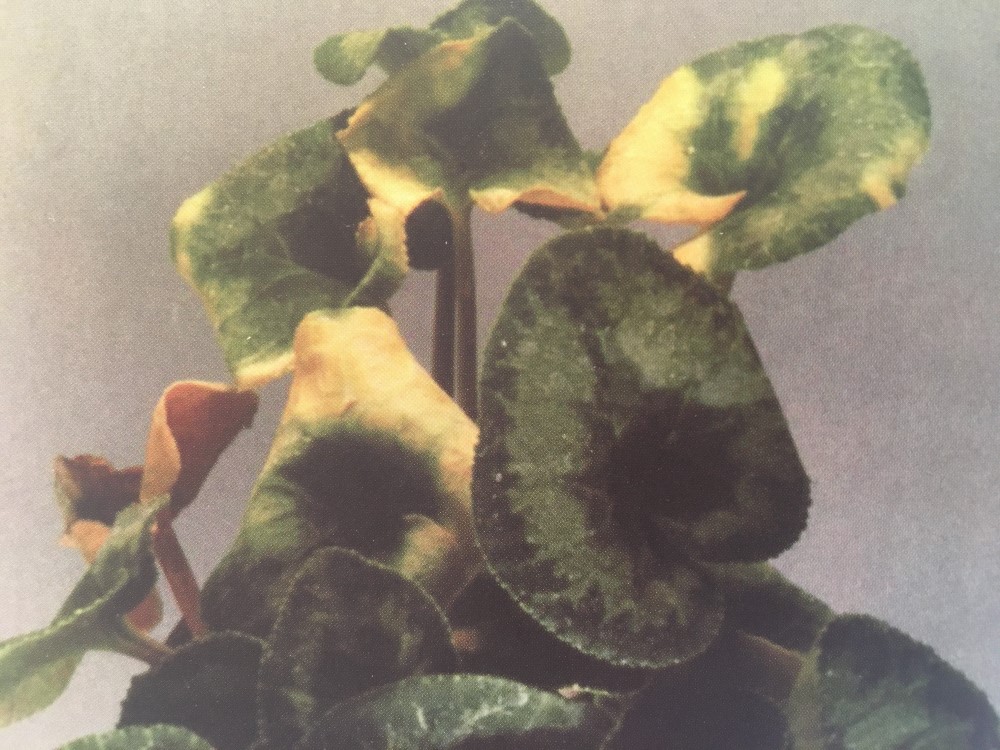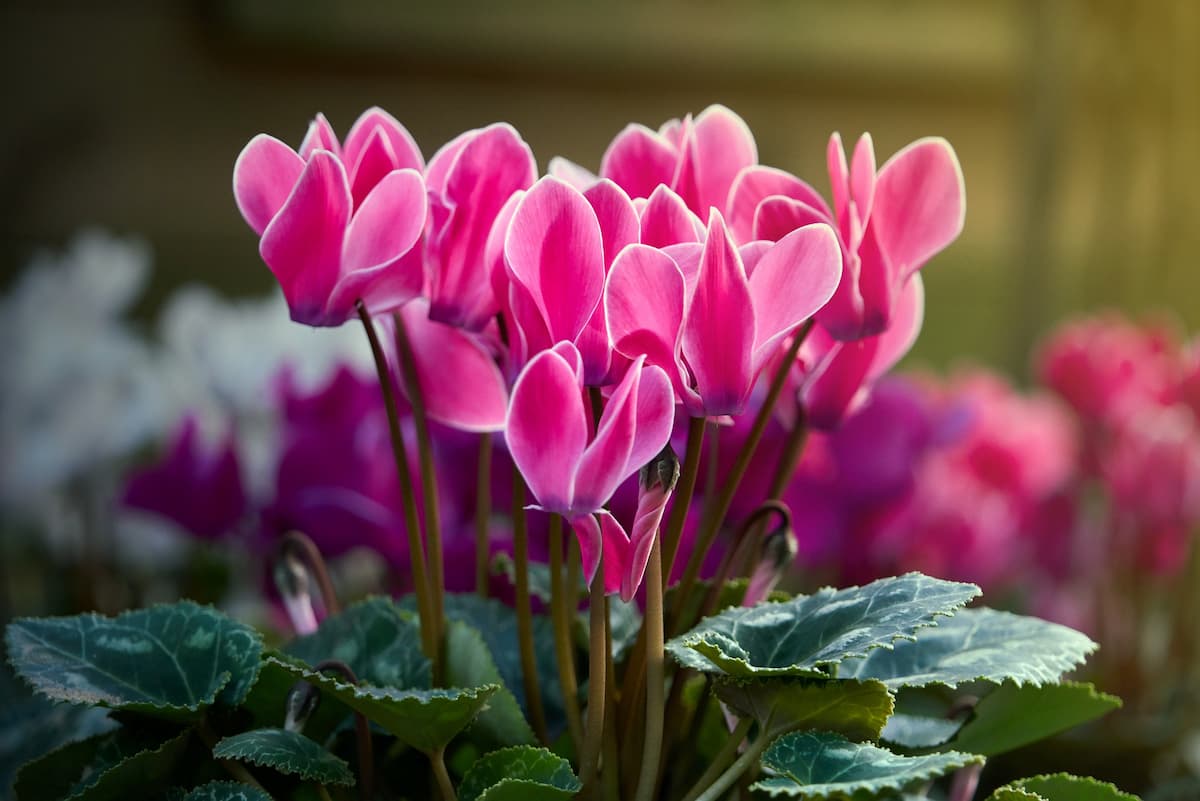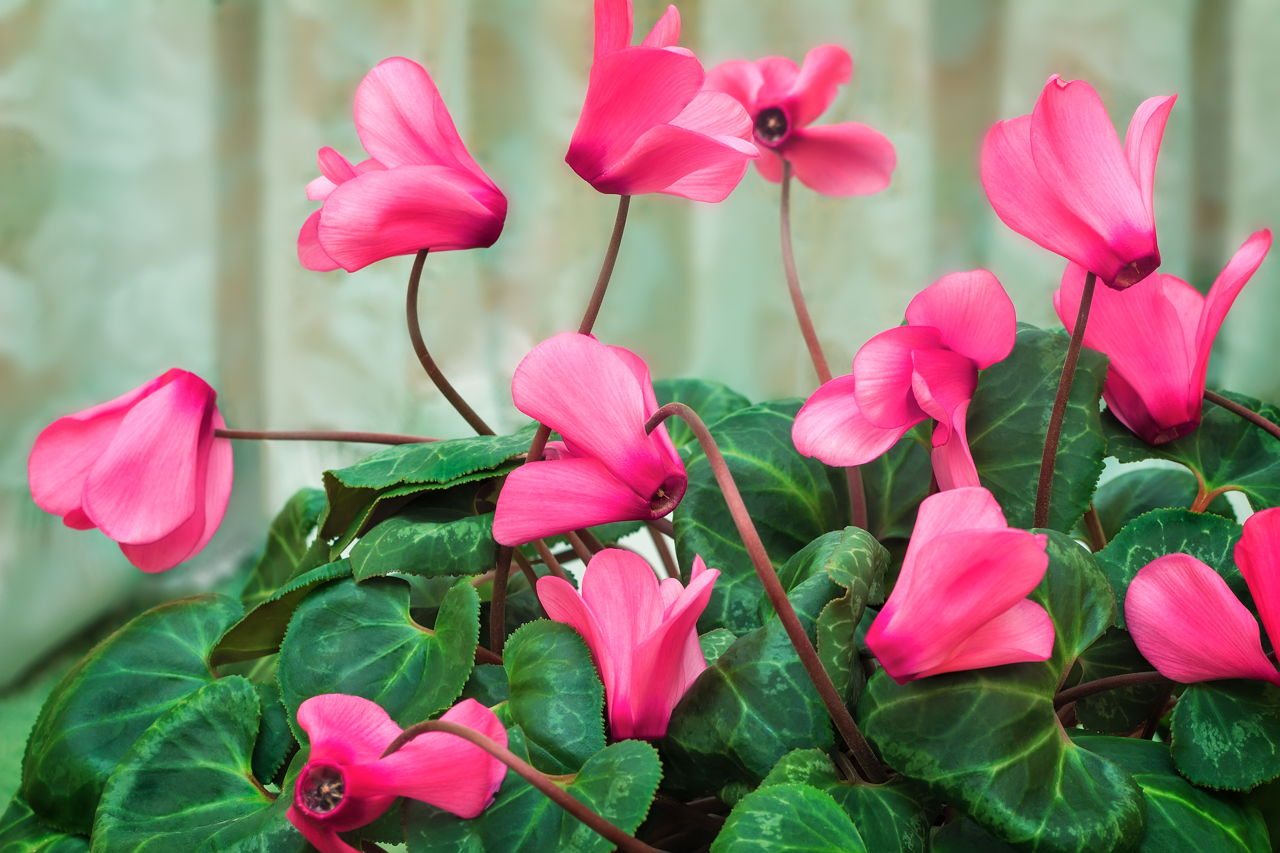What is a Cyclamen Plant and How to Identify It
The cyclamen plant is a perennial flowering plant that belongs to the Primulaceae family. Native to the Mediterranean region, cyclamen plants have been a popular choice among gardeners and plant enthusiasts for centuries. With their heart-shaped leaves and delicate, nodding flowers, cyclamen plants are a stunning addition to any garden or indoor space.
One of the most distinctive features of cyclamen plants is their unique leaf shape. The leaves are typically heart-shaped, with a pointed tip and a wavy margin. They can range in color from deep green to silver-gray, with intricate patterns and markings. The flowers, which bloom in shades of pink, white, and purple, are equally striking, with delicate petals and a prominent nose-like structure.
When it comes to identifying cyclamen plants, there are several key characteristics to look for. The leaves are typically 2-5 inches long, with a leathery texture and a distinctive shape. The flowers are equally distinctive, with a unique shape and coloration. If you’re looking for a picture of a cyclamen plant, you’ll want to look for images that showcase these distinctive features.
Cyclamen plants are also known for their unique growth habits. They typically grow from tubers, which can be divided and replanted to create new plants. This makes them a great choice for gardeners who want to propagate new plants and share them with friends.
Whether you’re a seasoned gardener or just starting out, cyclamen plants are a great choice for anyone looking to add some beauty and interest to their garden or indoor space. With their unique leaves and delicate flowers, they’re a stunning addition to any setting. And with a little practice, you can take stunning pictures of your cyclamen plant to showcase its beauty.
How to Take Stunning Photos of Your Cyclamen Plant
When it comes to capturing the beauty of your cyclamen plant, photography can be a great way to showcase its unique features and colors. To take stunning photos of your cyclamen plant, you’ll want to consider a few key factors, including lighting, composition, and camera settings.
Lighting is one of the most important factors to consider when photographing your cyclamen plant. Natural light is always the best option, so try to take your photos near a window or outside in the shade. Avoid using direct sunlight, as it can create harsh shadows and unflattering light.
Composition is also crucial when it comes to taking great photos of your cyclamen plant. Consider the rule of thirds, and try to place your plant off-center in the frame. This will create a more interesting and dynamic composition. You can also experiment with different angles and perspectives to add some visual interest to your photos.
When it comes to camera settings, you’ll want to use a macro lens or a close-up setting to capture the intricate details of your cyclamen plant. A low aperture (such as f/2.8) will also help to create a shallow depth of field, which will blur the background and emphasize the plant’s features.
Finally, don’t be afraid to experiment and try out different techniques to capture the beauty of your cyclamen plant. Whether you’re looking for a picture of a cyclamen plant to showcase its unique features or simply to enjoy its beauty, with a little practice and patience, you can take stunning photos that will make your plant shine.
Cyclamen Plant Pictures: A Showcase of Different Varieties
Cyclamen plants are known for their stunning beauty and diversity, with a wide range of varieties to choose from. From the delicate, heart-shaped leaves to the vibrant, nodding flowers, each cyclamen plant is a unique work of art. In this section, we’ll showcase a collection of images highlighting different types of cyclamen plants, including their unique characteristics and features.
One of the most popular varieties of cyclamen plants is the Cyclamen persicum, which is known for its large, showy flowers and heart-shaped leaves. This variety is often used in floral arrangements and is a popular choice for gardeners who want to add a touch of elegance to their outdoor space.
Another popular variety is the Cyclamen coum, which is known for its delicate, pink flowers and silver-gray leaves. This variety is often used in container gardening and is a great choice for gardeners who want to add a touch of whimsy to their outdoor space.
In addition to these popular varieties, there are many other types of cyclamen plants to choose from, each with its own unique characteristics and features. Whether you’re looking for a picture of a cyclamen plant to inspire your gardening projects or simply to enjoy its beauty, this showcase of different varieties is sure to delight.
From the vibrant, red flowers of the Cyclamen hederifolium to the delicate, white flowers of the Cyclamen purpurascens, each cyclamen plant is a unique and beautiful work of art. Whether you’re a seasoned gardener or just starting out, this showcase of different varieties is sure to inspire and delight.
Understanding Cyclamen Plant Care and Maintenance
Cyclamen plants are relatively low-maintenance, but they do require some care and attention to thrive. To keep your cyclamen plant healthy and happy, it’s essential to provide the right environment and care. In this section, we’ll discuss the essential care and maintenance requirements for cyclamen plants, including watering, fertilization, and pruning.
Watering is one of the most critical aspects of cyclamen plant care. Cyclamen plants prefer well-draining soil and should be watered carefully to avoid overwatering. Water your cyclamen plant when the soil feels dry to the touch, and avoid getting water on the leaves or crown of the plant. This will help prevent rot and other problems.
Fertilization is also important for cyclamen plants. Use a balanced, water-soluble fertilizer to feed your cyclamen plant during the growing season. Avoid overfertilizing, as this can damage the plant and cause more harm than good.
Pruning is another essential aspect of cyclamen plant care. Remove any dead or dying leaves or flowers to keep your cyclamen plant looking its best. You can also prune your cyclamen plant to encourage new growth and prevent it from becoming leggy.
In addition to these care and maintenance requirements, it’s also important to provide your cyclamen plant with the right environment. Cyclamen plants prefer bright, indirect light and temperatures between 60-70°F (15-21°C). They also prefer high humidity, so you may need to use a humidifier to keep your cyclamen plant happy.
By following these care and maintenance tips, you can help your cyclamen plant thrive and enjoy its beauty for months to come. Whether you’re looking for a picture of a cyclamen plant to inspire your gardening projects or simply to enjoy its beauty, with proper care and maintenance, your cyclamen plant will be a stunning addition to any room.
Cyclamen Plant Pests and Diseases: How to Identify and Treat Common Issues
Cyclamen plants are generally hardy and resistant to pests and diseases, but they can still be affected by certain issues. In this section, we’ll discuss some common pests and diseases that can affect cyclamen plants, including symptoms, causes, and treatment options.
One of the most common pests that can affect cyclamen plants is the spider mite. These tiny, spider-like insects can cause yellowing or bronzing of the leaves, and can also spin webs on the plant. To treat spider mites, use a gentle insecticidal soap or neem oil, and make sure to isolate the plant to prevent the infestation from spreading.
Another common pest that can affect cyclamen plants is the mealybug. These small, white insects can cause stunted growth and yellowing of the leaves, and can also secrete a sticky substance called honeydew. To treat mealybugs, use a gentle insecticidal soap or neem oil, and make sure to remove any affected leaves or stems.
Cyclamen plants can also be affected by diseases such as root rot and leaf spot. Root rot is caused by overwatering and can cause the roots to rot, leading to yellowing or wilting of the leaves. To treat root rot, reduce watering and make sure the soil is well-draining. Leaf spot is caused by fungal infections and can cause small, circular spots to form on the leaves. To treat leaf spot, use a fungicide and make sure to remove any affected leaves or stems.
Preventing infestations and infections is key to keeping your cyclamen plant healthy. Make sure to inspect your plant regularly for signs of pests or diseases, and take action quickly if you notice any issues. By taking these steps, you can help keep your cyclamen plant healthy and thriving, and enjoy its beauty for months to come. Whether you’re looking for a picture of a cyclamen plant to inspire your gardening projects or simply to enjoy its beauty, with proper care and maintenance, your cyclamen plant will be a stunning addition to any room.
Propagating Cyclamen Plants: A Step-by-Step Guide
Propagating cyclamen plants can be a fun and rewarding experience, and with the right techniques, you can create new plants to share with friends and family. In this section, we’ll explain the process of propagating cyclamen plants, including division, leaf cuttings, and seed propagation.
Division is one of the most common methods of propagating cyclamen plants. To divide a cyclamen plant, start by carefully removing the plant from its pot and gently washing away the soil from the roots. Use a sharp knife or pruning tool to separate the tubers, making sure each section has at least one growing point. Replant the divided tubers in a well-draining potting mix, and water thoroughly.
Leaf cuttings are another popular method of propagating cyclamen plants. To take leaf cuttings, choose healthy leaves with a long petiole (stem). Cut the petiole from the plant, leaving about 1-2 inches of stem attached to the leaf. Dip the cut end of the petiole in rooting hormone, and plant the leaf in a well-draining potting mix. Water thoroughly, and keep the soil consistently moist until roots develop.
Seed propagation is a more challenging method of propagating cyclamen plants, but it can be a fun and rewarding experience. To propagate cyclamen plants from seed, start by sowing the seeds in a well-draining potting mix. Keep the soil consistently moist, and provide bright, indirect light. It can take several months for the seeds to germinate, but with patience and care, you can grow new cyclamen plants from seed.
Regardless of the method you choose, propagating cyclamen plants requires patience and careful handling. Make sure to provide the right environment for the new plants to thrive, including bright, indirect light and consistent moisture. With proper care and attention, your new cyclamen plants will grow and flourish, providing you with beautiful blooms and a picture of a cyclamen plant to enjoy for months to come.
Cyclamen Plant Arrangements and Displays: Tips and Inspiration
Cyclamen plants are a versatile and beautiful addition to any room, and with a little creativity, you can create stunning arrangements and displays that showcase their unique features. In this section, we’ll provide tips and inspiration for displaying cyclamen plants, including container gardening, hanging baskets, and floral arrangements.
Container gardening is a great way to display cyclamen plants, and with a little creativity, you can create a beautiful and unique arrangement. Choose a container that complements the plant’s colors and textures, and add some decorative rocks or moss to create a visually appealing display.
Hanging baskets are another great way to display cyclamen plants, and they can add a touch of elegance to any room. Choose a basket that is well-draining and has a sturdy chain or rope, and add some decorative flowers or greenery to create a beautiful display.
Floral arrangements are a great way to showcase cyclamen plants, and with a little creativity, you can create a stunning arrangement that highlights the plant’s unique features. Choose a vase that complements the plant’s colors and textures, and add some decorative flowers or greenery to create a beautiful display.
Regardless of the display method you choose, make sure to provide the right environment for the plant to thrive. Cyclamen plants prefer bright, indirect light and consistent moisture, so make sure to place the display in a spot that meets these requirements. With a little creativity and care, you can create a stunning display that showcases the beauty of your cyclamen plant and provides a picture of a cyclamen plant to enjoy for months to come.
Conclusion: Enjoying Your Cyclamen Plant and Capturing Its Beauty
Cyclamen plants are a beautiful and rewarding addition to any garden or indoor space. With their delicate flowers and heart-shaped leaves, they provide a unique and captivating display that can be enjoyed for months to come. By following the tips and advice outlined in this article, you can learn how to care for and maintain your cyclamen plant, as well as how to capture its beauty through photography.
Whether you’re a seasoned gardener or just starting out, cyclamen plants are a great choice for anyone looking to add some beauty and interest to their garden or indoor space. With their unique features and colors, they provide a picture of a cyclamen plant that is sure to delight and inspire. By experimenting with different designs and styles, you can create a stunning display that showcases the beauty of your cyclamen plant and provides a lasting impression.
In conclusion, cyclamen plants are a wonderful addition to any garden or indoor space, and with the right care and attention, they can provide a beautiful and captivating display that can be enjoyed for months to come. By following the tips and advice outlined in this article, you can learn how to care for and maintain your cyclamen plant, as well as how to capture its beauty through photography. So why not give cyclamen plants a try and see the beauty they can bring to your garden or indoor space?







